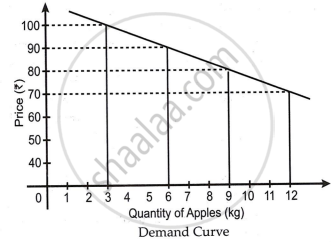Advertisements
Advertisements
Questions
State and explain the law of demand with the help of a hypothetical schedule and graph.
State and explain the law of demand with the help of a demand schedule and a demand curve.
Solution
The law of demand states that, other things remaining equal, the quantity demanded of a commodity increases when its price falls and decreases when its price rises. Thus, law of demand shows an inverse relationship between the price and the quantity demanded of a commodity. Let's understand the law of demand with the help of a hypothetical schedule and graph:
Demand Schedule for Apples
|
Price (per kg) |
Quantity demanded |
| 100 | 3 |
| 90 | 6 |
| 80 | 9 |
| 70 | 12 |
The economic demand schedule for apples is shown in the above table. Looking at the demand schedule above, we can observe that when apples were priced at ₹ 100 per kg, the economy as a whole demanded 3 kg of apples every month. Demand rises from 3 kg to 6 kg per month when prices drop to ₹ 90 per kg. Demand for the product rises to 9 kg per month when prices are further reduced to ₹ 80 per kg. As a result, the schedule shows that quantity demanded rises in response to a drop in apple price, illustrating the inverse relationship between the two variables.
The graphical representation of the schedule is called the demand curve.

The demand curve for apples in an economy is depicted in the graph above. Looking at the curve, we can observe that when the price was ₹ 100 per kg, 3 kg of apples was requested. The quantity requested rises to 6 kg when the price drops to ₹ 90 per kg and to 9 kg when the price drops to ₹ 80 per kg. This demonstrates that the quantity requested of apples rises while the price decreases, illustrating the inverse relationship between the two. Therefore, with the use of the demand schedule mentioned above and the graph, we can conclude that while other factors stay the same, the law of demand is valid because the quantity desired of a good rises with price increases and falls with price increases.
APPEARS IN
RELATED QUESTIONS
Complete the following statement:
Symbolically, the functional relationship between Demand and Price can be expressed as ______.
Find the odd word
Assumptions to law of demand -
The Law of Demand was introduced by ______.
State with reason whether you agree or disagree with the following statement.
There is an inverse relationship between price and demand.
Increase in demand is caused by
In case of relatively more elastic demand, the shape of the curve is
Distinguish between extension and contraction of demand.
Explain the law of demand and its exceptions.
State with reason whether you agree or disagree with the following statement :
When price of Giffen goods fall, the demand for it increases.
The following table shows the demand schedule for 3 consumers in a market.
| Price in (Rs) | Consumer 1 Demand in (kgs) | Consumer 2 Demand in (kgs) | Consumer 3 Demand in (kgs) | Market Demand |
| 10 | 1 | 2 | (i) ______ | 6 |
| 8 | 2 | (ii) ______ | 4 | 9 |
| 6 | 3 | 4 | 5 | 12 |
| 5 | 4 | 5 | 6 | (iii) ______ |
Based on the above hypothetical schedule answer the following questions.
- What is the demand of Consumer 3 priced at Rs 10 (i)
- What is the demand of Consumer 2 priced at Rs 8 (ii)
- Calculate the total market demand priced at Rs 4 (iii)
- From the above given table examine the relationship between price and demand.
- Mention any one exception to the law of demand.
If with the rise in price of good Y, demand for good X rises, the two goods are:
When at a price of ₹ 5 per unit of a commodity, A's demand is for 11 units, B's demand is for 14 units and C's demand is for units (assuming that there are only three consumers in the market), the market demand is ______.
Giffen goods are richman's goods
If prices of cars rise, many people may put off buying a new car. So the demand for petrol will fall.
If a good is inferior good, then purchases of that good will decrease when ______.
Pick the option which does not belong to the group:
State the law of demand.
Explain four circumstances under which the law of demand does not operate.
State whether the following statement is true or false. Give reasons.
The law of demand states a direct relationship between price and demand.
